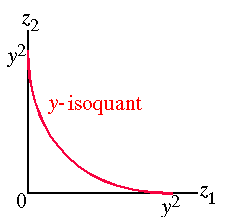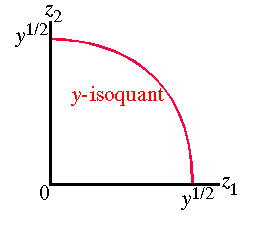1.3 Exercises on isoquants
- Draw some isoquants for the production function
F(z1, z2) = z1/2
1 + z1/2
2.The y-isoquant is given byy = z1/2or
1 + z1/2
2,z2 = (y − z1/2It is shown in the following figure.
1)2. - Draw some isoquants for the production function
F(z1, z2) = z2
1 + z2
2.The y-isoquant is given byy = z2
1 + z2
2.It is shown in the following figure.
- Find the MRTS for the production function
F(z1, z2) = z1/2
1 + z1/2
2.The y-isoquant is given byy = z1/2or
1 + z1/2
2,z2 = (y − z1/2so that
1)2MRTS(z1, z2) = (y − z1/2(Remember that the MRTS is the absolute value of the slope of an isoquant.)
1)z−1/2
1 = (z2/z1)1/2. - Which of the following production functions has a diminishing marginal rate of technical substitution?
- F(z1, z2) = z1 + z2.
- F(z1, z2) = z1/2
1z1/2
2. - F(z1, z2) = z2
1 + z2
2.
- For the production function F(z1, z2) = z1 + z2, the isoquants are straight lines. Thus the MRTS is constant, not diminishing.
- For the production function F(z1, z2) = z1/2
1z1/2
2, the isoquants are rectangular hyperbolae, hence convex to the origin. Thus the MRTS is diminishing. - For the production function F(z1, z2) = z2
1 + z2
2, the isoquants are quarter circles. Thus the MRTS is increasing, not diminishing.

